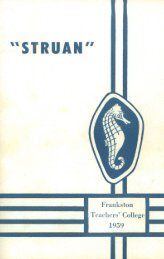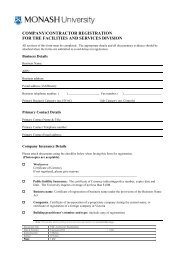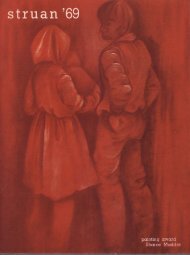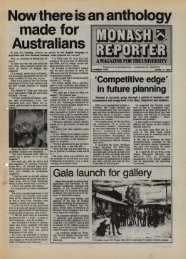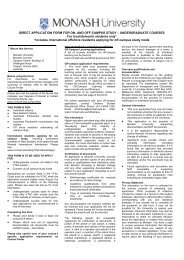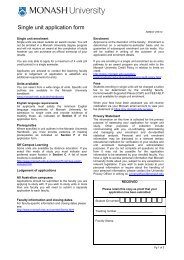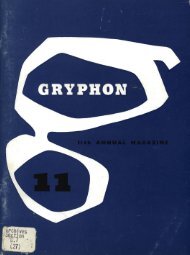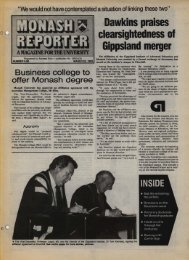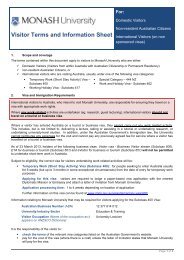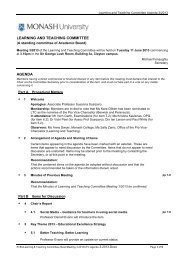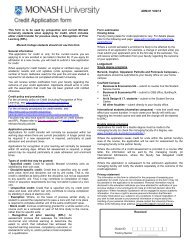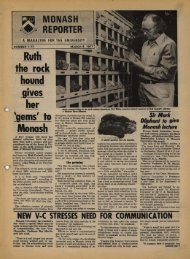Gone (down) but not forgotten - Administration, Monash University
Gone (down) but not forgotten - Administration, Monash University
Gone (down) but not forgotten - Administration, Monash University
You also want an ePaper? Increase the reach of your titles
YUMPU automatically turns print PDFs into web optimized ePapers that Google loves.
Unearthing a<br />
giant's secrets<br />
A combined <strong>Monash</strong>-Odense study of the Giant Gippsland Earthworm<br />
has revealed some secrets of the extraordinary creature's physiology and<br />
biochemistry.<br />
The two-metre animal, which has the cTuorin.<br />
thickness of a human thumb, is <strong>not</strong> only<br />
the world's largest earthworm <strong>but</strong> the<br />
largest terrestrial animal lacking<br />
specialised organs for transporting<br />
oxygen from the external environment<br />
'hrough 'he blood system.<br />
Or Baldwin says the most striking<br />
features of this pigment 3re its extremely<br />
high affinity for oxygen (about 50 times<br />
greater than of human haemoglobin)<br />
and the facilitation of oxygen binding by<br />
high carbon dioxide levels, which is the<br />
<strong>Monash</strong> zoologists Dr John Baldwin<br />
reverse of the situation in vertebrates.<br />
and Mr Fraser Hercus, in collaboration Other studies underway include<br />
with Professor Roy Weber of the measurements of the rate of oxygen<br />
Biology Institute. <strong>University</strong> of Odense,<br />
Denmark, have found the creature has a<br />
closed blood vascular system containing<br />
high concentrations of the oxygenbinding<br />
respiratory pigment, erythroconsumption<br />
by worms placed in artificial<br />
burrows, and an examination of<br />
enzymes involved in metabolic pathways<br />
used to provide energy in worms at rest<br />
and during activity .<br />
• Right Dr John Baldwin unravels a preserved specimen of the Giant Gippsland<br />
Earthworm.<br />
Working is a<br />
health hazard<br />
An Occupational Health Service has<br />
been established at the <strong>University</strong> wilh<br />
the major aim or tackling Repetition<br />
Strain Injury I aU hough it is concerned<br />
with all health problems associated with<br />
working conditions.<br />
The service. which operates from the<br />
<strong>University</strong> Offices, is directed by<br />
Associate Professor Tony Ryan, acting<br />
head of the <strong>Monash</strong> department of<br />
Social and Preventive Medicine.<br />
Consultant ergonomist, Mr David<br />
Caple, and the <strong>University</strong>'s specialist in<br />
organisation and methods, Mr Bob<br />
Lothian, are also involved. and there are<br />
occupational therapy and physiotherapy<br />
staff to assist in the treatment of workrelated<br />
conditions.<br />
• Tony Ryan<br />
8<br />
When it comes to counting,<br />
we've got the numbers<br />
Statistically speaking, Melbourne is<br />
rather well off.<br />
More than half the statisticians in<br />
Australia are trained in the Melbourne<br />
area, and about a quarter of Australia's<br />
statistics research effort is concentrated<br />
there.<br />
And that dominance looks set to continue,<br />
given a recent Federal Government<br />
decision to support the establishment<br />
of a 10int Centre for Statistical<br />
Sciences to be based at <strong>Monash</strong>,<br />
LaTrobe and Melbourne univerSItIes<br />
and the Royal Melbourne Institute of<br />
Technology.<br />
It will be one of seven key centres of<br />
teaching and research which will share<br />
about $3 million in the next three years.<br />
Key centres aim to improve teaching<br />
and research standards, help tertiary institutions<br />
respond to demands for their<br />
expertise and promote co-operation between<br />
higher education and industry.<br />
They are <strong>not</strong> the same as centres of excellence.<br />
which are concerned solely<br />
with pure research.<br />
The joint centre brings together two<br />
initiatives which were already being<br />
undertaken by the institutions.<br />
The first was to offer a coursework<br />
Masters degree in statistics.<br />
The second was the establishment of<br />
statistical consultancies for industry.<br />
The aim is to make the centre selfsupporting<br />
within the three years of the<br />
announced Federal program.<br />
Outcry over<br />
research<br />
on animals<br />
An unannounced visit by RSPCA inspectors<br />
in June threw <strong>Monash</strong> into the<br />
middle of a public controversy over<br />
animal experimentation.<br />
Accusations were made about the<br />
maltreatment of possums and other<br />
animals, and a number of outside<br />
academics and researchers leapt to the<br />
<strong>University</strong>'s defence.<br />
Melbourne <strong>University</strong>'s Professor<br />
Graeme Clark, who developed 'he<br />
bionic ear. said research into the hearing<br />
of possums at <strong>Monash</strong> had been very<br />
valuable, and Dr Margaret Rose from<br />
the Universi'y of NSW praised 'he<br />
general state of the facilities and standards<br />
of care ·in the Physiology department's<br />
animal house.<br />
The RSPCA's behavior over the incident<br />
was censured by the <strong>University</strong><br />
Council, which lodged an official complaint<br />
against the media over the "false<br />
claims and distortion of facts that had<br />
occurred on television and in the press" .<br />
• The director of Animal ServK:es, Dr Jim<br />
Adams, with tom cats born and raised in the<br />
Central Animal House. Photo - Tony<br />
Miller.<br />
NOVEMBER 13, 1985
THE YEAR OF ALUMNI •••<br />
Continuing contacts<br />
should have<br />
mutual benefit<br />
A welcome effect of the approach of <strong>Monash</strong>'s 25th anniversary next<br />
year is the stimulus given to the concept of alumni associations.<br />
Existing associations are out to expand<br />
membership through the fresh interest<br />
that the anniversary events will<br />
bring.<br />
At (he same time. at least three<br />
departments are working hard to create<br />
alumni associations, painstakingly seek-<br />
Invitation to<br />
'open house'<br />
The Chemistry Department is well<br />
under way with its plans for a Silver<br />
Anniversary reunion, and the formation<br />
of an alumni association.<br />
It has written to 490 past graduates at<br />
the B.Sc. (Honors) M.Sc. and Ph.D.<br />
levels and is sorting information on<br />
about 1000 pass graduates to write to<br />
next.<br />
It has written to professional associations,<br />
and some newspapers, and intends<br />
to advertise appropriately to reach<br />
as many interested people as it can.<br />
The department's chairman, Professor<br />
Ron Brown, estimated the<br />
numbers of chemistry graduates in<br />
<strong>Monash</strong>'s first 25 years as "in excess of<br />
2()(x)" .<br />
The 25 years of teaching and research<br />
have seen major changes within the<br />
depanment, as within the university<br />
itself, he says.<br />
The creation of a <strong>Monash</strong> chemists'<br />
Alumni Association must lead to regular<br />
social and professional contacts of benfit<br />
to all.<br />
The department plans a celebration<br />
day on Saturday, May 3. next year. This<br />
will include a Departmental Open<br />
House. followed by a reunion dinner,<br />
preferably on campus, which will be<br />
limited to about 700 guests.<br />
Early indications of interest are<br />
needed.<br />
Graduates should send name<br />
(including the name under which they<br />
graduated) and address to Dr Ernie<br />
Nunn at the department as soon as<br />
• Ron Brown<br />
MONASH REPORTER<br />
ing out graduates in Australia and<br />
overseas to invite their co-operation.<br />
The idea of alumni associations as<br />
fund-raisers and providers of social<br />
entertainment has largely been<br />
superseded.<br />
While their social<br />
mains, they are seen increasingly as the director of Alumni Affairs at Toronto<br />
groups through which the university and<br />
its graduates can develop and maintain a<br />
fruitful and potentially priceless<br />
reciprocal relationship.<br />
<strong>University</strong> departments, through their<br />
facilities. academic resources and contacts,<br />
are increasingly able 10 assist<br />
graduates and their professional groups.<br />
Graduales. in their turn, feed back into<br />
the university their innuence, experience<br />
and advice and help to provide<br />
work for undergraduates and graduates.<br />
The associations are an incomparable<br />
way for graduates to keep in touch with<br />
each other, for personal and professional<br />
reasons.<br />
North American experience · has<br />
shown a<strong>not</strong>her value of alumni groups.<br />
The nourishing ones generate public<br />
interest in university education, and in<br />
university problems like finance.<br />
..<br />
<strong>University</strong>, Canada, who was a principal<br />
speaker at a two-day workshop on alumni<br />
at <strong>Monash</strong> in August, alumni groups<br />
can have a significant inOuence on<br />
governments.<br />
"In our Province we have improved<br />
the public concern about universities<br />
dramatically, to a point where the<br />
government is strongly queslioned if<br />
cuts in support are proposed." he said.<br />
Ms Nancy McCabe, a leading US expert<br />
on alumni organisation and fund<br />
raising, emphasised that maintaining<br />
public interest in university problems required<br />
continuous and long-term investment<br />
of lime and money by the universities,<br />
the faculties, the students, and the<br />
graduates. to create a supportive<br />
climate.<br />
Alumni associations at <strong>Monash</strong> clearly<br />
have a major role in this creation of<br />
awareness and support. Here is a roundof<br />
their activities and<br />
• Staff liaison officer for the Mechanical Engineering Alumni ASSOCiation, Roger La Brooy, and association president, Jane Alcorn,<br />
pictu'red in the department's Academic Common Room. The wall of honor features photographs of Masters and Ph.D. graduates.<br />
Chapter may be formed in Asia<br />
The success of the Mechanical Engineering Alumni Association in its<br />
three years of existence shows how patient efforts to seek out graduates and<br />
get their co-operation can payoff.<br />
Memoersnlp at Just under 400<br />
amounts to more than 60 per cent of<br />
those contacted in Australia and<br />
overseas.<br />
(The more recent the graduates, the<br />
easier they are to find; whereas those of<br />
the 1960s are relatively hard to enlist,<br />
the response of those contacted last year<br />
amounted to 80 per cent.)<br />
There is the possibility of forming a<br />
chapter of alumni in Malaysia or<br />
Singapore.<br />
With foundations established. the<br />
association is now going ahead with the<br />
devising of a formal constitution.<br />
One committee meeting has been<br />
held, and according to senior tutor,<br />
Roger La Brooy, the staff liaison officer,<br />
some "pretty definite ideas" have<br />
already developed.<br />
The aims of the association are both<br />
social and professional.<br />
II held its lirst formal dinner in June,<br />
at the Regent, with Mr Bruce Irwin,<br />
general manager of Enterprise<br />
18<br />
Australia, as guest speaker.<br />
His subject was quality control in<br />
Australia.<br />
Professionally, the association<br />
already provides valuable interaction<br />
between the university and graduates, of<br />
benefit to both.<br />
Members can get access at <strong>Monash</strong> (0<br />
those with a broader spectrum of technological<br />
knowledge Ihan might otherwise<br />
be available.<br />
They may also be able to call on the<br />
department's highly specialised facilities<br />
on a professional basis as occasion<br />
arises.<br />
The department is particularly keen to<br />
inform alumni of the opportunity to further<br />
their professional careers by undertaking<br />
Masters degrees by coursework<br />
or research.<br />
Members may be able to provide<br />
vacation employment for present<br />
studenls, and ultimalely, al limes, permanenl<br />
jobs.<br />
In general. the existence of the<br />
association can lead to <strong>Monash</strong>'s work<br />
being far better known in the engineer.<br />
ing world.<br />
Some alumni have taken up particularly<br />
interesting careers.<br />
One is Jane Alcorn, the association<br />
president, an honors graduate of 1971,<br />
and a contract engineer with the Department<br />
of Housing Construction in<br />
Melbourne.<br />
She previously worked at Comalco's<br />
Weipa bauxile mine in Queensland, and<br />
gained experience in New Zealand and<br />
at Ok Tedi in Papua New Guinea.<br />
Her husband, Brenton, also a 1977<br />
graduate, is project manager of a<br />
Melbourne engineering firm.<br />
Roger La Brooy, a M.Eng.Sc.<br />
graduate of 1974, is now reading a<br />
Ph.D., specialising in robotics.<br />
The two most celebrated names<br />
among graduates, however, are probably<br />
lhose of John Bertrand, captain<br />
of AUSlI'tJ/io II in Ihe caplure of lhe<br />
America's CuP. and David Williamson,<br />
the playwright.<br />
NOVEMBER 13, \985
AND MORE ON THE<br />
Lawyers are late starters<br />
The <strong>Monash</strong> Universily Law Alumni associalion began in 1981, and<br />
loday has 350 members, or aboul 20 per cenl of Ihe lolal number of<br />
graduales since Ihe Law School began in 1964.<br />
Its experience is that graduates show<br />
relatively little interest in an alumni<br />
association when they first leave<br />
<strong>Monash</strong>.<br />
Their careers are only just beginning,<br />
and for most there is <strong>not</strong> all that much<br />
money to share (although the special<br />
new graduate subscription until April<br />
next year is only $5).<br />
It is later. when some success has<br />
come, that minds and hearts (Urn more<br />
to the old days, and subscriptions cheques<br />
at the full $10 rate are more<br />
frequent.<br />
Special occasions. such as this year's<br />
dinner in the Great Hall of the National<br />
Gallery, to mark the school's 21st<br />
anniversary. with the Governor General,<br />
Sir Ninian Stephen. as the guest speaker,<br />
stimulate membership.<br />
Attendance was a capacity 520, and<br />
the Master of Ceremonies was Campbell<br />
McComas.<br />
An annual dinner and a Christmas<br />
party are regular events.<br />
The association makes a <strong>Monash</strong><br />
<strong>University</strong> Law Alumni Award each<br />
year for the most magnificem comri<strong>but</strong><br />
ion to the Law School by an undergraduate.<br />
Normally in the black, it has been able<br />
to help the school library, and last year<br />
provided $2285 for books for the<br />
"reserve" section.<br />
Business group holds<br />
monthly meetings<br />
The major objectives of the <strong>Monash</strong><br />
<strong>University</strong> <strong>Administration</strong> Graduates'<br />
Association are the promotion of conti·<br />
nuing education and interaction between<br />
its members, the business community<br />
and the public sector,<br />
Its president, John Nolan, director of<br />
Finance and <strong>Administration</strong> at the State<br />
Electricity Comm ission, says the<br />
association comprises mainly graduates<br />
and students of the Master of <strong>Administration</strong><br />
Course conducted in the Faculty<br />
of Economics and Politics.<br />
Monthly functions are held at the<br />
Australian Institute of Management offices<br />
in St Kilda, with prominent<br />
speakers who have recently included the<br />
State Treasurer, Rob Jolly, the State<br />
Secretary of the AMFSU. John<br />
Halfpenny, and the managing director<br />
of Dunlop Olympic LId. . Mr John<br />
Gough.<br />
An innovation this year was a wellattended<br />
combined meeting with the<br />
Melbourne <strong>University</strong> Business School<br />
Association, Mr Nolan said.<br />
MAGA membership has reached 126<br />
and the association has affiliations with<br />
five corporations, which send senior<br />
executives to its functions.<br />
The 1986 program will be released<br />
soon, and Mr Nolan would like to hear<br />
from any administration graduates or<br />
current students interested in joining the<br />
association. He can be contacted on<br />
615 3903.<br />
"MAGA is strongly supported by<br />
Professor (Allan) Fels and Professor<br />
(Peter) FitzRoy of the department of<br />
Administrative Studies.<br />
Members get a copy of the <strong>Monash</strong><br />
<strong>University</strong> Law Graduate's Directory,<br />
with its 500 entries giving <strong>not</strong> only<br />
names, addresses and telephone<br />
numbers <strong>but</strong> also "professional, social<br />
and cultural" interests.<br />
These may range from "maintaining<br />
unmaintainable house" in one case to<br />
"actor and speech-maker , selfemployed"<br />
in the case of the celebrated<br />
Campbell McComas.<br />
In general, the aims of the <strong>Monash</strong><br />
<strong>University</strong> Law Alumni are to broaden<br />
members' professional contacts in the<br />
Law; to offer stimulating social and<br />
cultural activities; to enable members to<br />
draw on the resources and expertise of<br />
the school; and to also enable them to<br />
contri<strong>but</strong>e to its future development.<br />
All those interested in joining should<br />
get in touch with Mrs Judy Johnston at<br />
the Dean's office, ext. 3300.<br />
....<br />
• Peter FitzRoy<br />
"Members enjoy <strong>not</strong> only the intellectual<br />
st imulation of the program itself,<br />
<strong>but</strong> also the opportunity to renew<br />
acquaintances with former student colleagues,"<br />
he said .<br />
Potter appeals for ideas<br />
In its plans for creating an alul1)ni<br />
association, the Chemical Engineering<br />
department is trying to reach more than<br />
400 graduates to arouse their interest<br />
and invite suggestions, and to establish a<br />
Graduate Register,<br />
"There are many ways in which the<br />
department can be of service to an alumnus,"<br />
says the chairman, Professor<br />
Owen Potter.<br />
"Through its COntacts in business and<br />
industry, through its research facilities,<br />
through its specialised postgraduate<br />
courses, and through its academic staff.<br />
many of whom travel widely to advise<br />
and consult with industry.<br />
"At the same time, many possibilities<br />
exist for reciprocal help - professional,<br />
personal and financial.<br />
"Alumni of the department could<br />
provide publicity, potential students,<br />
suggestions and commissions for special<br />
research, openings for vacation experience<br />
for undergraduate students,<br />
placement of graduates, and comments<br />
on existing and proposed course structures,<br />
among other possibilities.<br />
"The department. the profession. and<br />
the community atiarge. could all benefit<br />
from such input."<br />
Professor Fotter lists among recent<br />
MONASH REPORTER<br />
departmental developments of interest Engineering, Bachelor of Science<br />
to all graduates: "graduate course work program" .<br />
programs; continuing education Everyone interested in the creafion of<br />
seminars and workshops; new areas of the alumni association should write to<br />
research, and a combined Bachelor of Professor Potter as soon as possible.<br />
Building new bridges<br />
The Civil Engineering Department is<br />
(rying (0 contact nearly 1000 graduates<br />
about the alumni association it is in the<br />
process of forming.<br />
Like other groups it is emphasising to<br />
prospective members that an association<br />
will have both social and professional<br />
benefits, and be important for the individual,<br />
the profession, the department,<br />
the university and the community<br />
at large.<br />
In a general letter to graduates, the<br />
department's chairman, Professor Eric<br />
Laurenson. points to the value of the<br />
department's facilities. academic expertise,<br />
specialised post-graduate courses<br />
and contacts with business and industry.<br />
The emphasis is on "reciprocal help".<br />
with alumni able to commission<br />
research, suggest fieldwork oppor<br />
II<br />
tunities, propose staff as consultants.<br />
provide temporary and full-time job<br />
opportunities for graduates, and advise<br />
on proposed course structures.<br />
He feels that, quite apart from the<br />
question of professional benefit, alumni<br />
will take pleasure in learning about<br />
other graduates, and about significant<br />
developments in the department itself.<br />
Graduates course work programs,<br />
continuing education seminars and<br />
workshops, new areas of research, and<br />
the combined Bachelor of Engineering,<br />
Bachelor of Economics program are<br />
among developments of the past few<br />
years_<br />
Professor Laurenson will be delighted<br />
to hear from all graduates interested in<br />
alumni association membership. no<br />
matter where in the world their careers<br />
have taken them.<br />
WAY<br />
•<br />
• Marilyn Pittard<br />
Medicine is<br />
gaining strength<br />
The <strong>University</strong>'s first alumni was<br />
formed in 1966, when 66 people joined<br />
the Association of <strong>Monash</strong> Medical<br />
Graduates.<br />
Today the membership is more than<br />
800, or about a third of all the facult y's<br />
graduates.<br />
"The association is going from<br />
strength to strength", the president, Dr<br />
Stewart Bowman, says in the AMMG's<br />
latest newsletter.<br />
He became president at an annual<br />
general meeting dinner at the Southern<br />
Cross Hotel in May, when Dr Earl<br />
Hackett was guest speaker.<br />
More than 220 graduates, including<br />
some from the first year (1966) attended,<br />
and all years were well represented.<br />
Dr Bowman is the fifth association<br />
president, following in the footsteps of<br />
Richard Dargaville, Peter Holmes, Andrew<br />
Slutzkin and Richard Travers.<br />
The larges t project yet to be undertaken<br />
by the association, Dr Bowman<br />
says, will be - it is hoped - the establishment<br />
of a Graduate Centre of<br />
Medicine at <strong>Monash</strong>.<br />
A ballot of members in May gave the<br />
committee an overwhelming mandate to<br />
proceed, and this support was confirmed<br />
at a meeting at <strong>Monash</strong> in August.<br />
Professor Gracme Schofield, Dean of<br />
Medicine, is delighted at the success of<br />
the association.<br />
"Your association is here to stay," he<br />
writes in the newsletter, and describes it<br />
.as "the most effective, best integrated<br />
and best organised" in Australia.<br />
One stimulus ' to membership Dr<br />
Bowman remarks, has been the holding<br />
of Ten Year Reunions - with the 1975<br />
graduates meeting this year.<br />
"It would appear that the advent of<br />
the Ten Year Reunion kindles some last<br />
urge, because all years that have had<br />
their reunion have high membership".<br />
he says.<br />
Those who have <strong>not</strong> paid the $25 a<br />
year membership subscription, or who<br />
would like to join the association, are<br />
asked to contact Valda Twaddle, at the<br />
Faculty of Medic ine, telephone<br />
(03) 541 2492.<br />
The association is planning to get as<br />
many graduates as possible together at<br />
the <strong>Monash</strong> Silver Jubilee celebrations,<br />
in co-operation with the Faculty of<br />
Medicine.<br />
"The faculty is examlOtng ways in<br />
which it will contri<strong>but</strong>e to the schedule<br />
of events." Professor Schorleld says.<br />
"Central to its planning will be<br />
opportunities for graduates to visit the<br />
Medical School and its departments."<br />
NOVEMBER Il. t915
Message of hope from the president<br />
The <strong>Monash</strong> Graduates Association achieved two <strong>not</strong>able "firsts" in<br />
1985.<br />
We produced the first issue of The<br />
<strong>Monash</strong> Graduate, a complimentary<br />
publication specifically oriented towards<br />
the interests of MGA members. (Of<br />
course, it is also intended to serve as a<br />
propaganda medium for the<br />
committee.)<br />
We decided to commit ourselves to a<br />
regular publishing schedule, <strong>but</strong> to go to<br />
press when there was sufficient material<br />
or a specific need to communicate.<br />
OUT olher "first" was a graduates'<br />
dinner. held at the <strong>Monash</strong> <strong>University</strong><br />
Club.<br />
Despite the cost being heavily subsidised<br />
by the association, attendance was<br />
poor.<br />
On the brighter side. those who did attend<br />
(32, including guests), were unanimous<br />
in recommending that the dinner<br />
became an annual event.<br />
We are also pleased we were able to<br />
bring a long-term MGA project to fruition<br />
this year.<br />
In 1981, the MGA committee, with<br />
assistance from the Australia Council,<br />
commissioned the composition of a<br />
Processional to be played on the Louis<br />
Matheson Pipe Organ during graduation<br />
ceremonies.<br />
The project suffered numerous setbacks<br />
for a variety of reasons, <strong>not</strong> the<br />
least being the initial unsuitability of the<br />
composition for the organ.<br />
Finally all the difficulties were over-<br />
Jubilee dinner<br />
<strong>Monash</strong> <strong>University</strong> will be celebrating<br />
its Silver JUbilee in 1986.<br />
Apart from various activities throughout<br />
the year, a week has been set aside<br />
for the <strong>University</strong> to celebrate the occasion<br />
- May 19-25.<br />
Representatives of the various<br />
Counselling staff in crisis<br />
The <strong>University</strong> Counselling Service<br />
had a crisis of its own Ihis )'ear. when<br />
three of its six professional stafr left for<br />
various reasons.<br />
Industrial<br />
liaison<br />
Plans for the development of an Of·<br />
fice of Inno\'ltion and Liaison went a<br />
step further in March with the part·time<br />
appoinlmenl of Mr Bill Algar as lhe<br />
Universil)" s first consultant on in·<br />
dustrialliaison.<br />
Mr Algar, a technical consultant with<br />
wide industrial and research experience,<br />
has been given a brief to advise and<br />
assist the Vice-Chancellor, Professor<br />
Martin.<br />
The proposed office is planned to help<br />
achieve one of the main objectives set<br />
<strong>down</strong> in the <strong>Monash</strong> <strong>University</strong> Act:<br />
"To aid by research and other means the<br />
advancement of knowledge and its prac·<br />
tical application to primary and secondary<br />
industry and commerce".<br />
MONASH REPORTER<br />
come, and Orgelwerk, by Richard David<br />
Hames, was presented to the Vice<br />
Chancellor, Professor Martin, at the inaugural<br />
dinner.<br />
Two delegates attended the Australian<br />
<strong>University</strong> Graduates Conference annual<br />
meeting in Adelaide in May.<br />
The main theme of this conference<br />
was fund raising by universities and<br />
their graduates, in support of university<br />
aims.<br />
The president attended a follow-up<br />
weekend workshop on the same theme<br />
during August.<br />
MGA offered to sponsor attendance<br />
at this workshop by faculty-oriented<br />
graduate associations.<br />
We were pleased that both the<br />
Medical and Mechanical Engineering<br />
graduates associations were able to<br />
attend.<br />
At the annual general meeting, the<br />
association recorded its thanks to those<br />
graduates who gave up much of their<br />
spare li!"e 10 help OUI al Ihe highly<br />
successful ANZAAS Festival of Science<br />
in August.<br />
We are involved in planning for a<br />
Graduate Dinner to be held during May,<br />
t986, as part of the 25th Anniversary<br />
celebrations.<br />
MGA members will receive further<br />
details soon.<br />
- David Harris,<br />
President, MGA<br />
graduates associations have been giving<br />
some consideration as to how graduates<br />
can be involved in the festivities.<br />
One suggestion was to hold a special<br />
Jubilee Graduates Dinner on either Friday.<br />
May 23, or Salurday, May 24, <strong>but</strong><br />
this could only be successful if there was<br />
strong support by graduates.<br />
A<strong>not</strong>her suggestion was to hold a<br />
Graduates Day during the week of celebrations.<br />
It would be unfortunate if graduates<br />
were <strong>not</strong> in some way involved in this,<br />
the first major landmark in the <strong>University</strong>'s<br />
history.<br />
Views of graduates would be<br />
appreciated <strong>but</strong> time is short if the planning<br />
of any activity is to be included in<br />
the program of events.<br />
Replacements have now been fo und<br />
for Heather McCormack, Sue Stephenson<br />
and Diana Taylor and the service is<br />
back to full strength to the relief of<br />
stalwarts, G raham .Briscoe, Robin<br />
Coventry, and Linda Clifton.<br />
Teie Triggs (wife of senior lecturer in<br />
psychology. Dr Tom Triggs). has taken<br />
responsibility for the extensive study<br />
• New members of the <strong>University</strong> Counselling Service staff, from leh, Tele Triggs, Sally<br />
Trembath and Janette Simmonds.<br />
12<br />
• David HarriS, right, and John O'Oonnell, the <strong>University</strong>'s organist-adviser, study the<br />
score of Orgelwerk.<br />
Heat wheel could<br />
aid solar cooling<br />
A heat exchanger developed by a <strong>Monash</strong>-led team, which could save<br />
Australian industry millions of dollars in energy costs, has also shown promise<br />
as a component of a solar air-condilioning system.<br />
The rotary regenerative heat exchanger,<br />
whose design was refined by a<br />
research team headed by Mr Charles<br />
Ambrose of Mechanical Engineering, is<br />
a large wheel straddling parallel ducts of<br />
incoming and exhaust air.<br />
As the wheel rotates it gathers heat<br />
from the exhaust duct and transfers it<br />
to the incoming air.<br />
skills program, while Sall y Trembath<br />
and Janette Simonds have become part<br />
of the regular counselling team.<br />
The service. which opened more than<br />
20 years ago, provides individual and<br />
group counselling on all issues affecting<br />
the lives of staff or students.<br />
It is located upstairs in the Union<br />
building, telephone ext. 3156.<br />
-<br />
Recent tests at an American solar<br />
research institute in Colorado by<br />
a<strong>not</strong>her member of the team have shown<br />
that the heat wheel can absorb and<br />
transfer moisture by means of a gel. It<br />
can thus form the basis of a solar air<br />
conditioning device.<br />
Research into the heat wheel was<br />
financed with more that $120,000 from<br />
the National Energy Research, Development<br />
and Demonstration Council.<br />
It has been installed at the Ballarat<br />
coating pla.nt of Associated Pulp and<br />
Paper Mills Lid (A PPM).<br />
According to the plant manager, Dr<br />
George Alcorn, the demonstration was a<br />
success from the start.<br />
The wheel <strong>not</strong> only reduced energy<br />
bills by enough to pay for the installation<br />
in just over 8 months, <strong>but</strong> recovery<br />
of the waste heat boosted the drying<br />
capacity of the mill, leading to an increase<br />
in paper production which could<br />
halve the payback period.<br />
.'m<br />
.plr.ny·WOIt!'Id<br />
.....' .....fI ..<br />
ribbon<br />
. , The rotary regenerative heal<br />
exchanger<br />
NOVEMBER 13. 1985
The year's best buy - one dollar the lot<br />
Healthy outlook for<br />
funeral directors<br />
Linda Brown is a graduate with a differente<br />
- she runs the Australian<br />
funeral industry.<br />
Ms Brown, who gained her BA<br />
(Honors) at <strong>Monash</strong> in 1980 and joined<br />
the Chamber of Manufactures, was<br />
assigned to look after the Australian<br />
Funeral Directors' Association.<br />
She became full-time executive director<br />
of both the Victorian division and<br />
the national association.<br />
Her job involves liaison with Government<br />
deparlments and the public, daily<br />
office administration, preparation of<br />
publications and arrangement of functions<br />
for members, including the AFDA<br />
annual convention.<br />
She is also edilor of both the national<br />
industry magazine, The Auslralian<br />
Funeral Director and the AFDA News,<br />
the Victorian bra nch quarterly<br />
newsletter.<br />
Ms Brown believes the people in the<br />
DVC started<br />
career as<br />
technician<br />
Professor Ian Chubb. a distinguished<br />
researcher in the neuroscienti£ic rield.<br />
has been appointed Deputy Vice<br />
Chancellor of the <strong>University</strong> of<br />
Wollongong.<br />
He started as a researcher while still a<br />
technician and part-time student at<br />
<strong>Monash</strong>. and although he does <strong>not</strong> have<br />
a first degree, he was accepted directly<br />
into the Masters program at Oxford on<br />
the basis of his previous research.<br />
He gained an M.Sc. and D.Phil. from<br />
Oxford and after some years as a<br />
research Fellow at St John's College,<br />
became a lecturer, and subsequently<br />
head of department, in Human<br />
Physiology at Flinders <strong>University</strong>.<br />
MONASH REPORTER<br />
fur•.:::ral industry are among the most<br />
genuine, caring people she has met, and<br />
they have a healthy outlook on life.<br />
.. Anyone can go out and set up in<br />
general business," she says.<br />
UBut it takes special qualities to be a<br />
good funeral direcror."<br />
• Brian Potton, supervisor in Computer Centre Operations, with part of the B7800<br />
computer which occupies a room 17m by 13m. Photo - John Keesing.<br />
The Computer Centre did some<br />
bargain buying in March when it acquired<br />
a S4 million Burroughs 81800<br />
computer package for the princely sum<br />
of $1.<br />
The transaction, arranged through the<br />
Victorian Government's "Offset Program".<br />
has given a significant boost to<br />
<strong>Monash</strong>'s research and undergraduate<br />
teaching.<br />
The computer is also available for use<br />
by state government departments and by<br />
approved prhace sector projects.<br />
Dr CUff Bellamy, director of the<br />
Computer Centre, says the B7800 was<br />
one of two major developments this<br />
year.<br />
The other was the completion of a<br />
new computing laboratory housing 350<br />
computer terminals, designed to provide<br />
facilities for teaching students in computer<br />
science, engineering and mathematics.<br />
Survey will aid handicapped<br />
Graduate Sue Shaw has been conducting a survey this year on ways of improving<br />
opportunities for handicapped students.<br />
On-campus storage places for for transportation, yet they are essential<br />
motorised wheelchairs are a very high to cover the long distances between<br />
priority, she says. buildings and departments.<br />
These big chairs can<strong>not</strong> be folded up The survey also shows that the<br />
Economics background<br />
helps in ACTU case<br />
Jenny Acton has the job of preparing<br />
a test case on equal pay for an Arbitra<br />
Cion Commission hearing early next<br />
year.<br />
As ACTU industrial officer, she has<br />
spent the past 12 months working on the<br />
issue, and the test case will be based on<br />
the <strong>not</strong>ion of comparable worth.<br />
Recenr stalisti cs showed the total<br />
average weekly earnings of women were<br />
66 per cent of what men were earning,<br />
and the ACTU will argue that a good<br />
part of the reason for this is because<br />
Address list<br />
The final issue of <strong>Monash</strong> Reporter<br />
for the year has an additional mailing<br />
list of close to 30,000 of the <strong>University</strong>'s<br />
graduates. and it's very difficuU to keep<br />
the addresses up-to-date.<br />
If your copy has been forwarded from<br />
an old address or you know you will be<br />
changing your address - or name <br />
before (he next graduates' issue in<br />
November. 1986, would you please<br />
return this form complete with all<br />
details.<br />
If you give insufficient information<br />
we may <strong>not</strong> be able to identify you.<br />
14<br />
women tend to work in a small range of<br />
traditional occupations which, being<br />
predominantly female, have lower pay<br />
scales.<br />
Ms Acton, who holds a Masters<br />
degree in Economics from <strong>Monash</strong>,<br />
believes nursing is a glaring example of<br />
an occupation undervalued in comparison<br />
with other jobs.<br />
She says if the comparable worth case<br />
fails, the ACTU will aim to have the<br />
principles changed to allow for a test<br />
case involving nurses.<br />
<strong>University</strong> needs to take a<strong>not</strong>her look at<br />
the "special considerations" policy<br />
within faculties and departments.<br />
Sue can be contacted through Loris<br />
Bates in the Faculty of Education, on<br />
ext. 2827. or at home on (059) 98 7239.<br />
• Sue Shaw<br />
Surname at time of graduation: ..................................... ..................... .<br />
Christian names: .......................................... ... .................................. .<br />
New surname if applicable: ........... ......... ... .........•...............................<br />
Last address <strong>not</strong>ified: ............................ , .. , ......................................... .<br />
... .. ... ............. ..... ............. ....•........ ...... Postcode: ......... ................... .<br />
New address: ............................................................................ ........ .<br />
...... ........ ...... .......... ......... ....... ..... ....... Postcode: ............................ .<br />
Degree and year graduated: .............................................................. .<br />
Student 1.0. number, if known: .. ......... ........•••.....................................<br />
NOVEMBER 13, 1985
Mathematics breaks new ground<br />
Optimisation is neither applied nor<br />
pure mathematics, by traditional<br />
reckoning, <strong>but</strong> partakes of both.<br />
It has roots in Lagrange's multipliers<br />
of 200 years ago and in 19th century<br />
calculus of variations, and essentially<br />
also in Dantzig's "simplex method" for<br />
computing linear programs (about<br />
1950), which, with the modern availability<br />
of computers, enables many quest40ns<br />
in economics and management to<br />
be optimised.<br />
During the last twenty years,<br />
generalisation from linear organisation<br />
to nonlinear optimisation, and in particular<br />
to convex optimisation, have<br />
produced a new mathematical area,<br />
linked to linear algebra and functional<br />
analysis <strong>not</strong>ably convex sets and functions,<br />
with the geometric Hahn-Banach<br />
theorem as an essential technique <br />
which attracts much attention in North<br />
America and Europe.<br />
It is therefore pleasing that the initial<br />
volume in the Australian Mathematical<br />
Society's Lecture Series should be an<br />
introduction, for students of pure<br />
mathematics. to this growing area.<br />
c The scope of the book is indicated by<br />
the chapter titles, and some of the subheadings,<br />
namely geometry and linear<br />
algebra (convex sets, matrices and vectors,<br />
pivotal condensation, vector orderings,<br />
etc.). linear programming (LP problems,<br />
primal and dual problems, a<br />
simplex method), elementary convex<br />
analysis (separation properties, convex<br />
functions, Fenchel transforms, extremal<br />
and smoothness properties), and<br />
nonlinear programming (duality,<br />
Lagrangians, canonical convex problems,<br />
quadratic programming),<br />
together with extensive sets of exercises<br />
in each chapter, and comments on the<br />
solulions al Ihe end of the book.<br />
There are a considerable number of<br />
IN REVIEW<br />
Introduction to Linear and Convex Programming<br />
by Nell Cameron<br />
Australian Mathematical Society Lecture Series 1<br />
Cambridge <strong>University</strong> Press<br />
RRP $53 hardcover, $18.50 paperback<br />
• Neil Cameron at the party in the bookshop to launch his new work.<br />
Third year students in applied and<br />
pure mathematics received a special<br />
delivery of Neil Calneron's new book,<br />
Introduction to Linear and Convex<br />
Programming, for use during third<br />
term.<br />
Pre-publication copies were flown out<br />
from England a month before the official<br />
worldwide publication date, for a<br />
pre-launch launching at the <strong>University</strong><br />
Bookshop.<br />
Since the official publication in early<br />
September, the book has made an impact<br />
in mathematics circles.<br />
Melbourne <strong>University</strong> recently invited<br />
Dr Cameron. to give a lecture to third<br />
year students about some of its aspects.<br />
iI1ustrative diagrams which help the Much required backgroun'd and techreader.<br />
nique is detailed in the book, rather than<br />
The presentation is careful and detail assuming it is already known.<br />
ed, including various worked examples. In particular, this applies to the parts<br />
Ambushed in the dark<br />
o '" suddenly found myself ambushed<br />
by sofl green lights peering up from the<br />
forest floor. After several nervous attempts<br />
to frighten the creatures away, I<br />
hurried back to my bush hut and safe·<br />
ty," wriles photographer, Bruce Fuhrer.<br />
"An inspection of the scene the next<br />
morning yielded only clumps of large<br />
white toadstools around the bases of<br />
many trees.<br />
"I collected some and took them to<br />
the hut. That night all was revealed: on<br />
extinguishing my lamp Ihe toadstools<br />
slowly became visible. glowing with a<br />
sofl greenish luminescence which grew<br />
IN REVIEW<br />
A Field Companion to Australian Fungi<br />
by Bruce Fuhrer<br />
The Five Mile Press. RRP $16.95<br />
brighter as my eyes adjusted to the dark.<br />
"After a while I could read the print<br />
of newspaper on which the fungi were<br />
resting. "<br />
Thus begun Mr Fuhrer's fascination<br />
with fungi, and his many years' work in<br />
studying and photographing these<br />
• Phaeogyroporus portentosus, probably Australia's largest terrestrial fungus, is<br />
found in quantitIes in the Jock Marshall Reserve. It can grow up to one metre in<br />
diameter.<br />
MONASH REPORTER<br />
17<br />
neglected forms of plant life have been<br />
brought together in A Field Companion<br />
10 Australian Fungi.<br />
His range of subjects is surprisingly<br />
vast. with many beautiful colors and<br />
forms.<br />
Each species is presented in its natural<br />
environment to show differences in<br />
habitat and substrate, and they are arranged<br />
to emphasise relationships.<br />
"The aim of this book is to share my<br />
interest and to introduce the fascinating<br />
world of fungi." Mr Fuhrer says.<br />
A senior technical officer in the<br />
Botany department, and an active<br />
member of Victorian naturalist and<br />
conservation movements, his work has<br />
been featured in a number of other<br />
publications.<br />
They include Flowers and Plants oj<br />
Victoria, Tree Diseases in Victoria,<br />
Seaweeds oj A ustralia and A Field<br />
Guide 10 Ihe Common Genera oj Gitled<br />
Fungi in Australia.<br />
Four of his fungi photographs provid.<br />
ed the basis for a series of Australian<br />
stamps depicting fungi, which were<br />
of linear algebra required for linear and<br />
convex programming; linear algebra<br />
courses are <strong>not</strong> always adequate here.<br />
The treatment is finite dimensionalalthough<br />
many results will extend. with<br />
minimal change, to infinite dimensions.<br />
While computing aspects are <strong>not</strong><br />
discussed, mathematical aspects of the<br />
simplex and a<strong>not</strong>her algorithm are considered<br />
carefully.<br />
Separarion of convex sets, and Fenchel<br />
transforms. are clearly formulated<br />
and illustrated.<br />
The last chapter includes Lagrangian<br />
duality, and Kuhn-Tucker conditions<br />
for convex problems.<br />
This book includes two valuable new<br />
things.<br />
The careful treatment of the simplex<br />
method includes a simple approach to<br />
preventing cycling.<br />
(This would nOI be hard to add to a<br />
LP computer program).<br />
Also, the discussion in chapter four of<br />
quadratic programming includes a<br />
detailed analysis, <strong>not</strong> to be found elsewhere,<br />
of Beale's algorithm, which is<br />
probably the best available for quadratic<br />
programming.<br />
I hope that many students (and<br />
teachers of mathematics) will buy, and<br />
study, Ihis book.<br />
They will learn a lot from it.<br />
Dr Bruce Craven,<br />
Reader in Mathematics,<br />
<strong>University</strong> of Melbourne.<br />
<strong>Monash</strong> Reporter is indebted to the<br />
editors of The Australian Mathematical<br />
Society Gazette for allowing us to publish<br />
this review before it appears in their<br />
December issue.<br />
Members of the society receive a 20 per<br />
(;ent discount if they purchase the book<br />
directly from Cambridge <strong>University</strong> Press.<br />
• The favorite habitat of Crepidotus variabills<br />
is small branches and twigs in moist.<br />
sheltered places.<br />
drawn by Celia Rosser, artist in the<br />
Botany department.<br />
A Fiela Companion to Australian<br />
Fungi has been greeted with enthusiasm<br />
by naturalist groups in Australia and<br />
Britain.<br />
"(11) is Ihe single mOSI useful field<br />
guide to appear for Australia and will be<br />
indispensable to naturalists," writes<br />
Stephen Forbes in the Victorian<br />
Naturalist.<br />
An anicle in the Bulletin ojthe British<br />
Mycological Institute says: "This is a<br />
book to stimulate interest in the fungi<br />
and to encourage their collections in a<br />
country as poorly explored mycolo·<br />
gically as Australia ... the photographs<br />
are of the highest technical standard" .<br />
Mr Fuhrer has also made a series of<br />
posters of fungi, which are available<br />
from the Botany department.<br />
NOVEMBER 13, 1985
GREAT STAIRWAYS<br />
OF THE WORLD<br />
• This month's stairway no doubt has a purpose, even if it is <strong>not</strong><br />
immediately obvious to the viewer. Its exact location tends to be a<br />
secret, <strong>but</strong> enthusiasts can track it <strong>down</strong> in the eastern end of the<br />
Education building. Photos - Tony Miller.<br />
Water clocks dampen<br />
hot air enthusiasts<br />
The 'organisers of a recent international hydraulics conference turned to<br />
<strong>Monash</strong> engineer, Dr Deane Blackman, to provide them with the<br />
appropriate technology for pulling speakers into line - water clocks.<br />
The clocks, which timed the speakers<br />
o ....er intervals from three to 40 minutes,<br />
at the 21st Congress of the International<br />
Association of Hydraulic Research, proved<br />
a polite and effective means of<br />
policing the line between interest and<br />
boredom.<br />
Dr Blackman, senior lecturer in<br />
Mechanical Engineering and an expert<br />
in the field of fluid dynamics, said his<br />
interest in ancient technology - and<br />
particularly, things Roman - was well<br />
known.<br />
(Water clocks were used to time the<br />
speeches of barristers in the Roman<br />
courts.)<br />
The five clocks he designed consisted<br />
of a black cone-shape with a solid bOltom<br />
and open ·top.<br />
The cone was attached to a central<br />
brass rod, the top of which carried a<br />
decorative horse and to the bottom of<br />
which weights could be screwed.<br />
In use, the cone was floated on water<br />
in a perspex cylinder. Water entered a<br />
small hole in its base at a rate determined<br />
by the size of the weight.<br />
When a speaker's time had elapsed,<br />
water reached the top of the cone and the<br />
whole contraption sank <strong>down</strong> the<br />
cylinder, giving a whole new meaning to<br />
the term "going <strong>down</strong> the tube" .<br />
"The response was very favorable.<br />
They worked quite well.<br />
"Over 40 minutes they were accurate<br />
to within about 30 seconds and over<br />
three minutes to within about 10<br />
seconds," Dr Blackman said.<br />
<strong>Gone</strong> (<strong>down</strong>) <strong>but</strong> <strong>not</strong> <strong>forgotten</strong><br />
The gallant vessel, Sir John <strong>Monash</strong>.<br />
lies in five metres of water in the shadow<br />
of the <strong>Monash</strong> bridge.<br />
Having acquitted itself nobly in battle,<br />
the magnificent craf( was shamelessly<br />
pirated and sunk by angry rivals.<br />
(ts captain, Rob Trebilco, and the<br />
crew went <strong>down</strong> with honor, saluting all<br />
the way.<br />
Fortunately such infamy had splendid<br />
outcome, for it was only fitting that<br />
<strong>Monash</strong> <strong>University</strong>'s entry in the grand<br />
Concrete Canoe Race should find its<br />
resting place in a hallowed spot by the<br />
Anderson Street bridge, built across the<br />
Yarra by <strong>Monash</strong> and Anderson,<br />
consulting engineers, in 1899. (The<br />
human victims re-surfaced).<br />
The vessel, with its 7mm shell strengthened<br />
by a new silicone fume admixture<br />
(which reduces the number of voids in<br />
the concrete), was constructed as part of<br />
a fourth year program in concrete technology<br />
by Civil Engineering students.<br />
The second <strong>Monash</strong> <strong>University</strong> entry<br />
(the previous one was four years ago) in<br />
the annual race, it fought successfully<br />
through [he heats before losing out to<br />
twO boats in the final.<br />
Both were mostly fibreglass, for the<br />
competition rules allow for construction<br />
using concrete and any additives, in<br />
unspecified quantities.<br />
Supervisor, Dr Peter Darvall, Reader<br />
in Civil Engineering, says towards the<br />
end the riverside crowd was chanting for<br />
Sir John, <strong>but</strong> "it was beaten by unfortunate<br />
wind and current".<br />
However. he claimed moral victory,<br />
for having "the only genuine concrete<br />
MONASH REPORTER<br />
boat on the river"; the closest rival, the<br />
Royal Melbourne Institute of Technology<br />
entry, having snapped in half<br />
while being unloaded from its trailer.<br />
"We had boating parties from the colleges<br />
hassling us all the way; Chisholm<br />
organised the race and Chisholm won,"<br />
he says.<br />
seven in the race) that they sent one as a<br />
rammer - <strong>but</strong> it couldn't catch us in the<br />
heats.<br />
"We're highly encouraged by the<br />
results and the next stage will be to go<br />
into higher technology for the canoe<br />
shape."<br />
(Sydney <strong>University</strong> used origami prin<br />
for the First International Concrete<br />
Canoe Race in Stockholm earlier this<br />
yeaL)<br />
Dr Darvall said teams of students<br />
would attempt the salvage of the Sir<br />
John <strong>Monash</strong>, which would be mounted<br />
for display on the east side of the department's<br />
laboratories, next to the<br />
"It had so many boats (four of the ciples to construct a six metre canoe from the W''''!!a''<br />
• Dr Peter Darvall, right. sentor tutor, Mr Rafael Grzebieta, second from right, and fourth year Civil Engineering students display the Sir<br />
John <strong>Monash</strong> before its fateful involvement in the grand Concrete Canoe Race. The vessel's vital statistics are: length 4m, width .7m, shell<br />
thick:-.ess, 7mm, and weight 4O-SO kg.<br />
20 NOVEMBER 13. 1985<br />
Printed by Waverley Otlset Publishing Group. (03) 560 5111 . Typ&Sel by BP Typesetting Ply. lid.• (03) 561 2111



